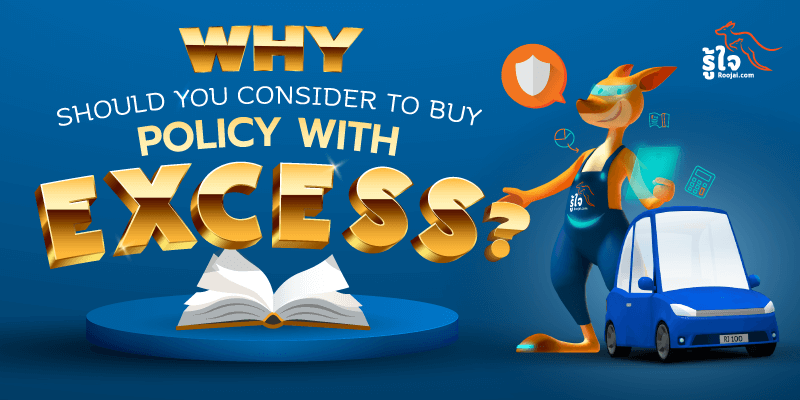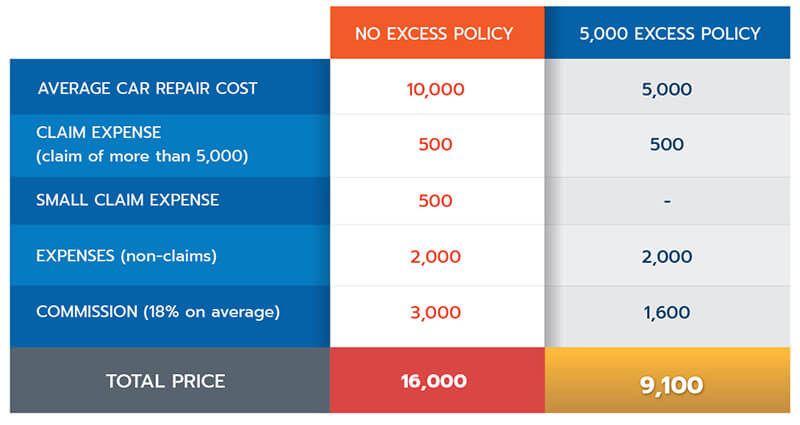
The Thai car insurance market is unique compared to other Asian market and worldwide. That’s because most of the car insurance policies sold in Thailand are without excess.
Based on our experience at Roojai.com, this is one of the reasons for the high number of road accidents in Thailand. Contrary to common belief, no-excess policies do not benefit the customer, the insurer or the overall society.
The only winners in this context are the agents and brokers earning higher commissions on inflated insurance premiums.
What is the Insurance Excess?
The excess is the maximum amount that a driver will payout for an accident when they are at fault, or there is no third-party involved. It is, in simple words, the amount of risk that the driver retains before the insurer takes over the rest of the bill.
If the driver is not at fault in a car accident, they don’t have to worry about the policy excess. The insurer will recover the damage from the third-party at fault, and the excess will not need to apply.
Here is an example.
Let’s say a driver hits a pillar in a car park. They have a 5,000 THB excess on the car insurance policy, and the car repair bill is 12,000 THB. It means that the insurer will pay 7,000 THB, and the driver will pay 5,000 THB. It is pretty straightforward. If the car repair cost is 3,000 THB, the driver can repair the car, without submitting an insurance claim. In this way, the insurance premium and the No Claim Bonus will not be affected.
Here is why no-excess insurance is worse.
Most drivers believe it is better to have an insurance policy without excess. You have nothingto worry about, and the insurance company pays for everything in case of a car accident. It sounds great. Not if you look a bit deeper on how car insurance prices work.
When there is no excess, every little damage becomes an insurance claim which requires the insurance company to intervene. For example, when someone reports a 3,000 THB claim for a small dent, the car insurance company will open a file and have a claim handler to send a surveyor to review the damage. Then they will discuss with the garage to approve the car repair. Afterwards, they will receive a quotation from the garage, authorize it, receive an invoice and pay the invoice. That is a lot of people managing a lot of paperwork for a 3,000 THB insurance claim. The cost of handling an insurance claim is on average, about 2,000 THB, without including the actual repair. While customers may think they do not have to pay, the insurance premium calculation includes all these expenses, and they impact everybody. Statistically, one accident out of two is for an insurance claim below 5,000 THB. These claims generate very high costs for insurance companies. The companies, of course, include these costs in the car insurance premiums.
Why are so many no-excess car insurance policies sold in Thailand?
If it is a lose/lose situation for both driver and insurer, why is no-excess insurance so common? The simple answer is because there is one big winner in the transaction: the intermediaries. Agents’ and brokers’ remuneration is a percentage of the car insurance premium. They usually get paid 18% of the premium so the higher the insurance premium, the better for them. For this reason, they tend to promote insurance policies without excess with the simple message: ‘It is much better for you. You don’t have to pay for anything, and the insurer will pay every cost’. It is indeed a great simple message. But one that does not stand scrutiny because you are paying much more upfront than you should.
Let’s have another example.
The average car repair cost is 10,000 THB per year. An insurance company needs to manage all insurance claims, including small claims : On average, 3000 THB for the whole servicing of policy (issue policy, send documents, offices, etc.) Out of the 3000, 1000 THB is for managing insurance claims, out of which 500 to manage small claims below 5000 THB. Then the agents take 18% of the total car insurance premium. So the total insurance premium is:
16,000 = 10,000 (car repair cost) + 2,000 (insurance company expenses, non-claims) + 500 (manage claims of more than 5,000) + 500 (manage small car accidents) + 3,000 (broker agent commission % of insurance premium)

Now, continuing with our example, let’s assume the customer choose excess insurance of 5,000. On average, it will reduce the repair cost carried by the insurer to 5,000. It will also reduce the cost of managing insurance claims by 500 by removing the small claims. The cost without commission becomes
5,000+2,000+500 = 7,500.
The intermediaries are taking 18% of the premium, but now the car insurance premium is
5,000 + 2,000 + 500 + 1,600 = 9,100
The customer would have to pay the excess when they have a car accident at fault or without a third-party, which is on average an additional 5000.
That makes the total cost on average 9,100 + 5,000 = 14,100, which is a saving of 1,900 THB. This saving comes mainly from the broker remuneration, reduced from 3000THB to 1600THB. Also, there is a 500THB in cost-saving from the insurance company since they don’t have to manage small claims.

One can easily understand that the main losers in this equation are the intermediaries, and that’s why most intermediaries will advise you to buy a no-excess insurance policy.
Another benefit of excess insurance is that small insurance claims won’t be reported. So, they won’t impact the driving record of the insured driver with his insurance company. At the time of renewal, the driver can benefit from an improvement in its No Claim Bonus.
Why would it benefit customers and society if more drivers used insurance policies with excess?
Another benefit of policies with excess is that drivers with an excess drive better. On average, people with insurance excess do fewer road accidents. If a driver knows that a car accident will generate a cost, he/she will take fewer risks. With a no excess insurance policy, the driver bears no consequences in a car accident. It would not be a big deal if that caused implications only for the driver and its car. Unfortunately, reckless driving has an obvious consequence which often can lead to injuries or death of other people. There is a correlation between the high number of road accidents in Thailand and the preponderance of zero excess insurance policies.
In conclusion, we strongly advocate for buying an insurance policy with excess to save money, for yourself and others, and to reduce the risk of road accidents.




